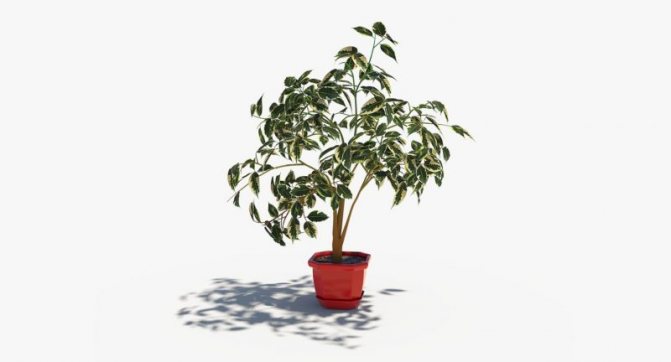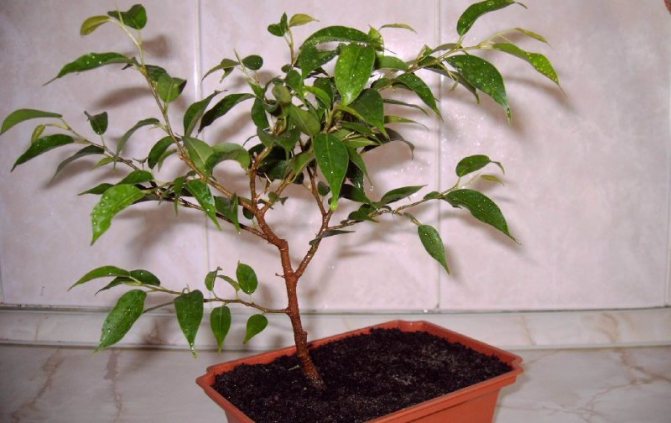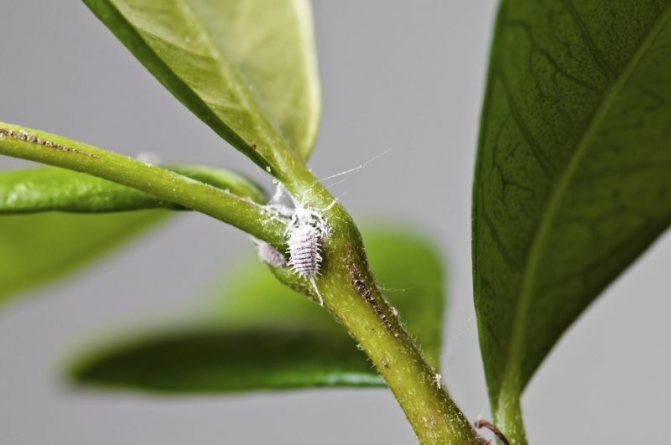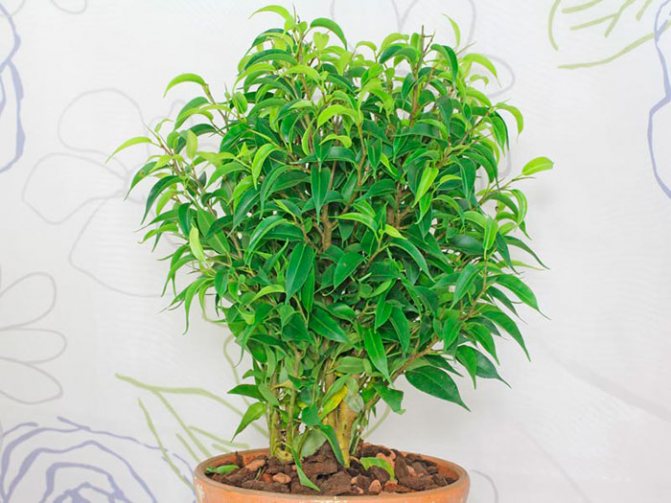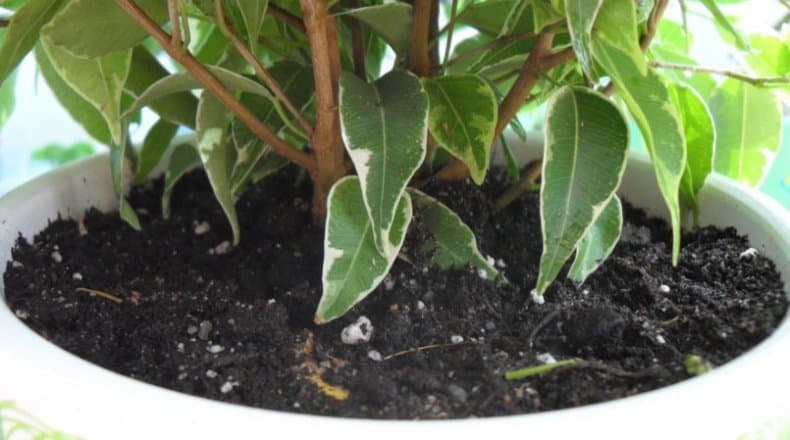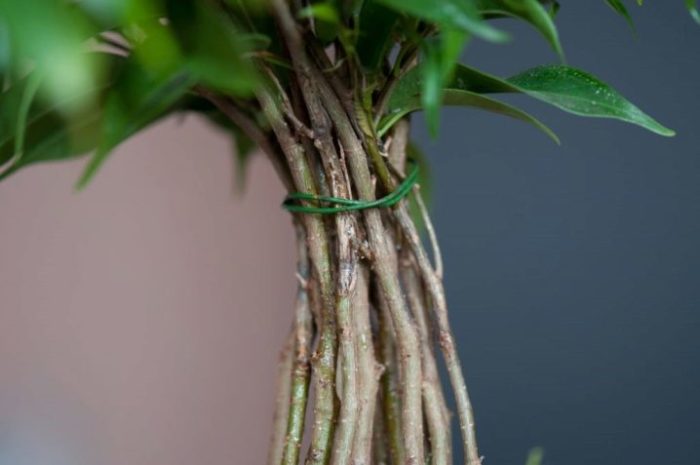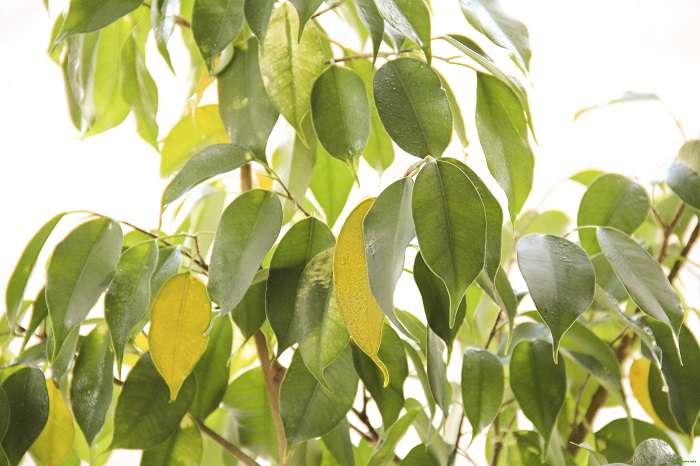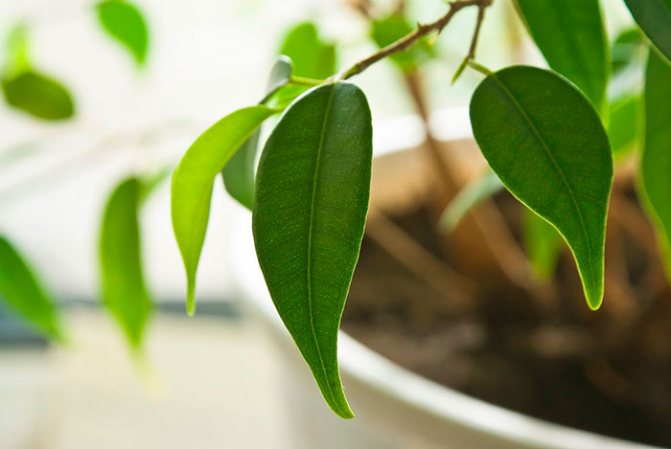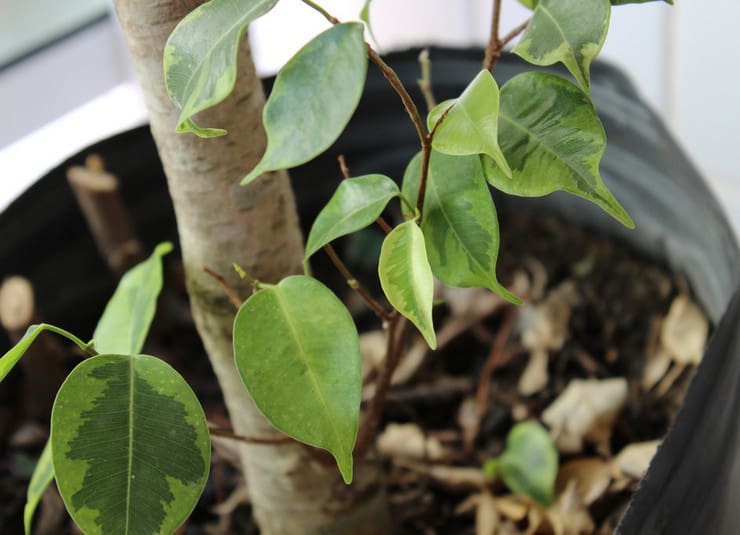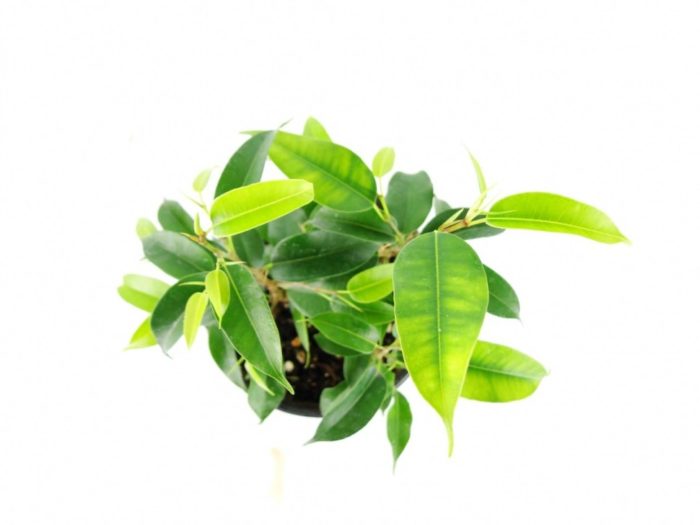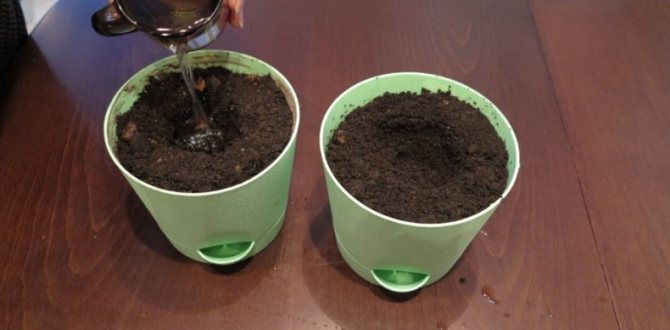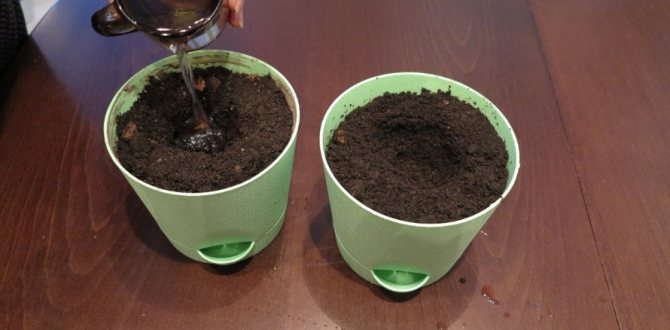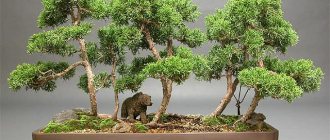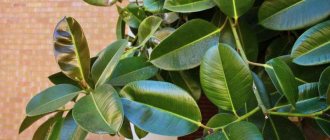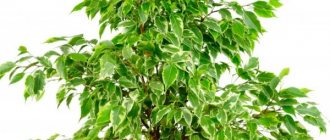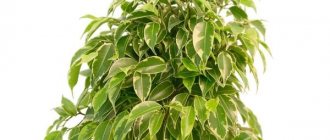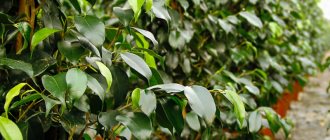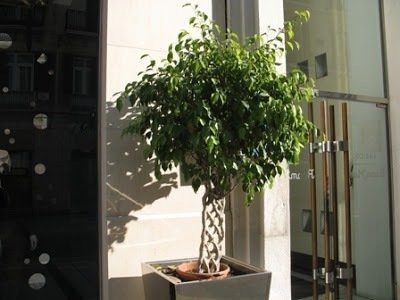
If you want to decorate your apartment, diversify the interior, love unusual flowers, then Benjamina Natasha ficus is a plant for you.
This dwarf bonsai with small green leaves will not leave anyone indifferent and will live in your apartment for a long time, becoming its decoration.
The homeland of this plant is Southeast Asia, Ceylon and the tropics of Australia. In warm tropical climates, these plants grow up to 5 meters in height.
Ficus "Benjamina Natasha": general description and photo
Ficus leaves
Ficus Benjamina Natasha is a small-leaved bonsai with oval wavy leaves of the Mulberry family.
The ficus "Benjamin Natasha" has leaves from 6 to 9 centimeters.
Shaping the trunk
Ficuses of this species lend themselves well to pruning, they are given any interesting shapes. They often make a tree on a trunk.
Ficus trunks are quite flexible, and they often plant several plants in one pot, intertwine them with each other.
It grows at home quickly enough and turns into a beautiful dwarf tree with proper care.
Ficus "Benjamina Natasha (Natalie)" photo:
Is bonsai suitable for formation?
Regular pruning allows not only to awaken dormant buds and increase the splendor of the crown, but also to give it any shape. The most common option is a tree on a trunk, which is a straight, bare trunk, decorated with a spreading dense crown.
Ficus weaving is also popular among flower growers - the possibility of forming various forms from the trunks of ficuses in the case of planting several specimens in one flowerpot. So, for weaving a "pigtail" you need 3 shoots, for a spiral 2, for a "lattice" - at least 6.
Does your ficus plant Benjamin Natasha grow?
You can also use ficus to form bonsai. The main challenge is to limit root growth by planting the plant in a small flat flowerpot and trimming the roots regularly. The branches and the trunk can be guided with a wire.
Home care
Features of care after purchase
Ficus "Benjamina Natasha" care is not very easy. With proper watering, lighting and humidity, the plant grows into a beautiful little tree and pleases the hostess with greenery all year round.
Then the young are transplanted once a year, most often in the spring during the active growth of the shoots, then as the pot becomes small for roots.
When the ficus grows more than one and a half meters, it is advised not to change the pot, but just fill up the earth, because such a large plant is not very convenient for transplanting, and the root system of ficuses is quite sensitive and requires very careful handling.
Lighting


Ficus Benjamin is very photophilous, light makes the leaves of the plant glossy.
Ficus loves bright light and tolerates direct sunlight.
For this type of plant, windows facing southeast or southwest are perfect.
Try to rotate the plant as often as possible so that it receives light evenly from each side.
Standing in partial shade, he will develop worse, and a curvature of the trunk may occur, as the ficus will “reach for the sun”.
Temperature
Ficus Benjamina Natasha, like any other tropical plant, is very thermophilic.
The optimum temperature for it will be 25-30 degrees.
With constant spraying, it will be easier to tolerate hot weather.
If you have a loggia or balcony, then this place will be an excellent solution for a plant for the summer.
Air humidity
Ficus grows well in rooms with high humidity.
He will enjoy frequent spraying, especially during dry summer months.
You can also periodically triple your pet with a "warm shower".
Watering
Ficus "Natali" prefers regular moderate watering, it is best to use warm, settled water.
In summer, as the top layer of the earth dries out, in winter, less often, but not allowing the roots to completely dry out.
Crown formation


If you want to give a beautiful shape to the crown of your ficus, then it is best to start doing this in a young tree, since the shoots of the ficus quickly take a horizontal position and the tree turns out to be one-sided.
Often several bushes are planted in one pot, they are intertwined with trunks among themselves, then these places can grow together.
It turns out a thicker and more branched plant.
Fertilizers and feeding
It is best to feed the plant during the period of their greatest growth, that is, in summer and spring.
Liquid fertilizers for ficuses and palms are perfect for this purpose.
Transplant and soil
The plant is transplanted very carefully, the ficus benjamin has very sensitive roots.
It tolerates transplanting best in spring during active growth.
The soil is advised to take fertile and breathable.
You can also add sand and humus to the soil.
Lighting and a comfortable place
The tree reacts negatively to frequent movements, so you need to immediately determine where the flowerpot with the plant will be located. It should not be placed near heating appliances, in a draft and in the shade - the complete absence of light leads to foliage falling off.


Lighting should be bright and diffused, it is best to put the ficus on the sill of the southeast or southwest window, shading will be required on the south side, since direct sunlight falling on the crown of the tree is the cause of burns on the leaves.
Throughout the year, except for the active growing season, it is necessary to turn the plant relative to the light source. This helps to avoid curvature of the trunk and to achieve uniform development of the shoots.
Reproduction
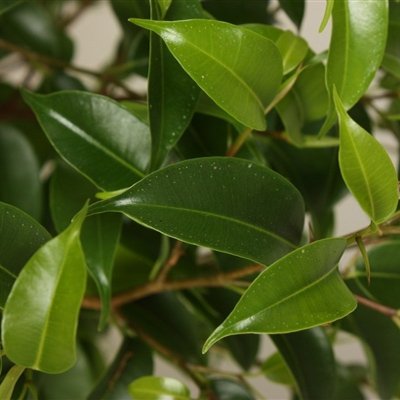

Reproduction is mainly carried out by cuttings, the roots are perfectly formed in water. The recommended temperature is 25-30 degrees.
You can also plant the cutting in a specially prepared soil with moss and cover with foil. Most often, cuttings with roots are planted in the ground.
It is advised to wash off the juice escaping from the cut, otherwise the vessels will clog and the roots may not appear.
It is quite difficult to grow ficuses from seeds at home.
Flowering and fruits
Flowering in this species of ficus is rarely observed, and most often it occurs in natural habitat.
What are the ways to prevent diseases?
Usually diseases and pests arise from inappropriate care or lack of necessary conditions. For prevention, you can also regularly monitor the humidity of the air, avoid excessive watering, monitor the dryness of the soil and periodically apply top dressing to improve the condition of the flower.


To avoid flower diseases, it is worth taking care of it carefully.
Benefit
Ficus has long been called the "Family Flower". It is believed that the family in which this plant appeared will soon have children.
This type of ficus has a wonderful property - it is able to cleanse the air from benzene and phenol, converting them into amino acids.
It makes an invaluable contribution to the indoor climate.
Scientific name
Ficus Benjamina Natasha is named after the outstanding British botanist Benjamin Daydon Jackson, the compiler of the renowned guide to floriculture. Also, this tree is a symbol of Bangkok.
Photo gallery
It has an invasive root system, in its natural environment it grows up to 10-15 m, at home it does not exceed 40-50 cm.
It has a beneficial effect on indoor air by converting benzene and phenol into amino acids.
In places where leaves or shoots are damaged, it secretes milky sap, which is not only toxic to pets and people, but can also cause allergic reactions upon contact with it.
Diseases and pests
Why does the ficus "Benjamin Natasha" fall off the leaves? What to do?
In leaving, the plant is quite whimsical.
With a lack of light in the cold season, when the plant cools (drafts), the ficus "Benjamina Natasha" sheds its leaves.
And in no case should you fill the flower - it will also drop all the leaves.
The main pests affecting the leaves and trunk of the plant are mealybugs, aphids, scale insects and spider mites. A cotton pad moistened with soapy water or alcohol solution will help get rid of pests.
Special preparations such as "Karbofos", "Inta-vir", "Actellik" are also successfully used.
With proper care, timely watering and a comfortable temperature, the ficus grows well, quickly acquires new leaves and turns into a beautiful little tree.
Pests. Table
| Pest | Signs | How to fight |
| Shield | A sticky bloom appears on the leaf plates, and on their back side, along the veins, brown spots | Wash the leaves with soapy water, treat with Aktellik, Aktara or Fitoverm |
| Spider mite | Gray-brown spots are noticeable on the leaves, the crown withers and falls off, then the ficus is covered with a thin web | Treatment with insecticides will be required ("Akarin", "Apollo") |
| Thrips | There is a deformation of the shoots, the appearance of brown spots on the leaves, their fall | Spray the tree with Aktellikom, Tanrekom |
| Mealybug | A cotton-like bloom forms in the leaf sinuses | Spray ficus with tobacco infusion or soapy water, treat with "Confidor" |
| Nematodes | The plant withers, nodular growths appear on the roots | To use insecticides ("Akarin", "Omite"), but it is almost impossible to save the plant |
| Aphid | Leaves become sticky and curl, insects are visible on the back | Use "Akarin" or "Fufanon" |
How the Natasha ficus differs from other species: description with photo
This variety belongs to dwarf ones, so a huge tub is not needed to keep it. If the relatives of the ficus Benjamin in the wild reach 10 meters in height, then "Natasha" at home will grow to 40, to a maximum of 60 cm. Among other features:
- Flexible barrel. Several ficuses can be intertwined, twisted together, giving a unique appearance.
- This variety is suitable for creating miniature trees using the bonsai technique.
- The elongated leaves are small, up to 3 cm in length, curved inward with a boat.
- The color of the leaves is from dark green to light green, there are specimens with minor yellowish veins and white blotches.
With the help of crown formation, it is easy to get a compact tree or lush bush.
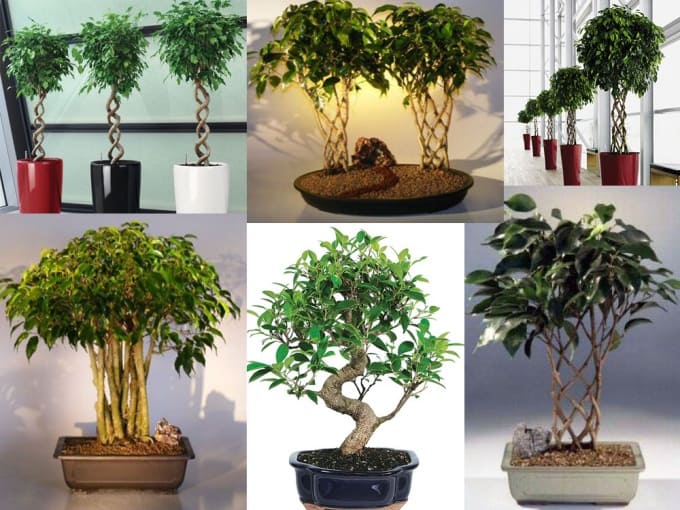

Watering and feeding
It is better to water Natasha in several stages. Thanks to this, it will be possible to achieve an even distribution of the liquid in the ground. Watering must be carried out only with water that has settled at least during the day. The water temperature should be at room temperature.


It is worth watering the plant with settled water.
Ficus does not tolerate dry soil, but excessive watering with water will also be harmful to it.Therefore, it is recommended to pour out the water remaining in the pan after watering, otherwise the roots of the flower will rot and it will die.
If at some point in time the leaves of the ficus began to turn yellow, the reason may be poor watering or a change in regime. All that needs to be done is to help the tree adapt and establish its watering regime.
Important! As for feeding, it is better to carry it out in the spring-summer period, since it is at this time that the plant begins to grow actively. You can feed the flower with the help of mineral fertilizers, but you should monitor compliance with the dosage. If you want to achieve a dense flower crown, then nitrogen fertilizers can be used.
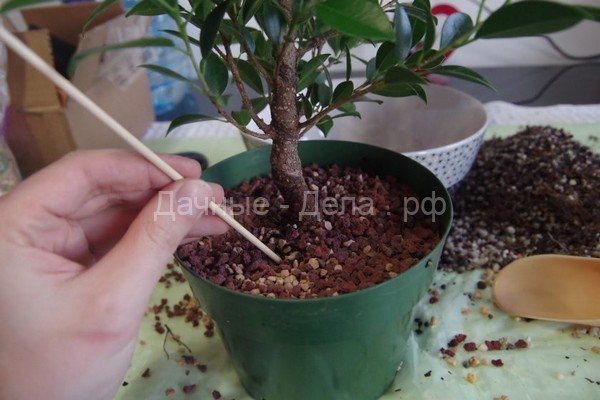

It is better to feed the plant during the period of active growth, i.e. in warm seasons
It is worth noting that it is not recommended to use various dressings at the same time, since the tree may suffer as a result of this from the fungus.
The most important thing about caring for Natasha: 6 main rules
Benjamin's ficuses cannot be called overly whimsical, but they should not be left unattended for weeks, like cacti. Compliance with simple rules will allow you to grow a healthy and effective indoor flower.
Note! After the purchase, Benjamin's Natasha ficus needs adaptation in a new place. Therefore, even in spite of the unsightly pot, the plant is transplanted after 2-3 weeks.
When growing at home, the following guidelines should be followed.
Rule # 1. Temperature regime
Ficus "Natasha" feels most comfortable when the temperature in the room is between 20 and 25 degrees. In winter, the flower goes into a natural state of dormancy, so it must be kept cool: the lower limit for varieties with monochrome leaves is + 10ºC, for variegated ones - + 15ºC.
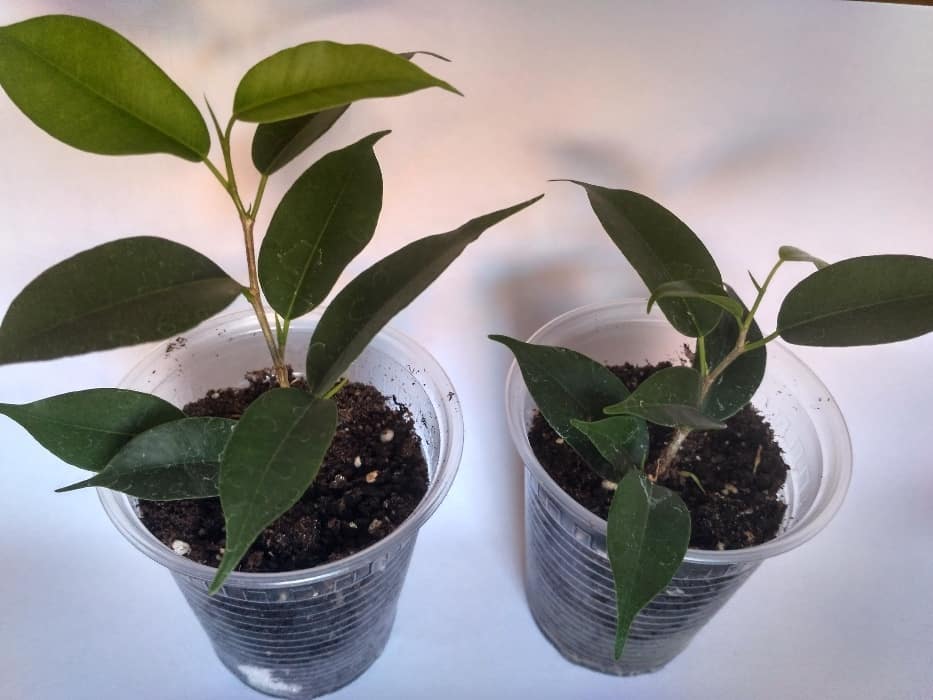

Rule # 2. Lighting
Benjamin's ficuses are not very demanding on light, but when grown in the shade, the leaves acquire a rich dark color.
The best option is diffused lighting throughout the day. You can place the pots on the east and west windowsills. On the south side, it is better to shade the plant, since intense rays can burn the foliage.
Rule # 3. Watering
The ancestors of the Natasha ficus are from the tropics, therefore they do not like stagnant moisture and too dry soil. For proper watering, use these tips:
- the soil is moistened when it dries up by 2-3 cm (you can check by sticking a wooden stick);
- water only with settled water (let it stand in an open container for 2-3 days), the temperature of the liquid should be equal to room temperature;
- 20-30 minutes after watering, drain the water from the pan of the pot;
- "Natasha" does not like too dry air, so maintain the optimal rate of 55-60% by spraying the crown from a spray bottle 2-3 times a week;
- after watering and spraying, do not open the windows - Benjamin's ficuses are sensitive to drafts.
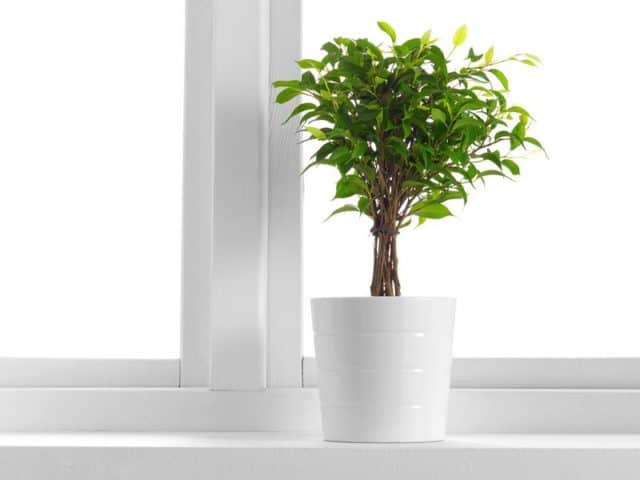

Rule # 4. Transplanting and soil selection
All ficuses do not easily endure the transplant, replacing the pot is very stressful for them, so the plants are transplanted only when absolutely necessary.
Note! Since Benjamin's ficuses grow rather slowly, young specimens are transplanted every 2 years, mature ones - no more than 1 time in 4-5 years.
The best time for replanting is spring, since active vegetation helps to quickly overcome stress. The new soil in the pot should be loose, nutritious and well-drained. Good soil is obtained from a mixture of equal proportions of turf, leafy soil, peat and sand.
Rule # 5. Fertilizers
The color saturation and splendor of the crown depend on the general health of the plant, therefore, additional fertilizing must be introduced into the diet of "Natasha". Fertilized ficus Benjamin throughout the growing season with a frequency of 10-14 days.
For feeding, use ready-made complex mixtures marked "for ficus" or standard mineral fertilizers.
Rule # 6. Pruning
The peculiarity of the Natasha ficus Benjamin is its strong branching and rapid growth of deciduous mass. A beautifully designed crown not only gives a decorative and well-groomed appearance, but is also a necessary part of the care. The best pruning time is in spring, when there is intense growth.
The formation of the crown is carried out according to the same principle as in shrubs - protruding branches are cut off with sharp sterile scissors at an angle upwards.
On a note: since new shoots grow from the buds, you can adjust the shape and density of the leaves by pinching: when removing the apical ones, the growth will go in width, the lateral ones - up.
What kind of soil is needed?
The main thing is that the soil should be soft, loose and fertile, allow moisture and air to pass through and have a weak acidity (pH 5.5–6.5). You can use potting mixes for ficuses or palms sold in florist shops or prepare the substrate yourself from equal parts:
- turf;
- coarse sand;
- leafy land;
- peat.
You can make the soil looser by adding a little perlite to it, and dolomite flour or charcoal should be used to lower the acidity.
To get rid of dangerous microorganisms and disinfect the soil, it must be heat treated (steamed or frozen) or spilled with a manganese solution.
Ficus weaving: what is it
Many growers use the flexibility of the trunks to create original compositions. For this, young plants are suitable, which are planted in one container. After adaptation in a new place, the lateral shoots in the lower part of the trunk are removed, the trunks are neatly intertwined with an oblique or plait.
For fixation, jute twine, thick woolen threads, cotton tapes are used. After 6-10 months, at the points of contact, the trunks will grow together, forming a common trunk with an unusual texture.


How to form a crown?
To grow a real handsome man and decorate a room with it, it is necessary to form his crown correctly. This is done by trimming. As for the shape of the crown, they often resort to the following:
- ball;
- multi-tiered bole;
- complex shapes, if it seems necessary.
It is better to start forming a crown in young ficuses due to their active growth. Pruning should be carried out in early spring, when the plant is emerging from dormancy and begins to actively release shoots. If desired, you can carry out pruning in winter, autumn, summer. But this is only if the flower at the time of the need for pruning has very elongated shoots.
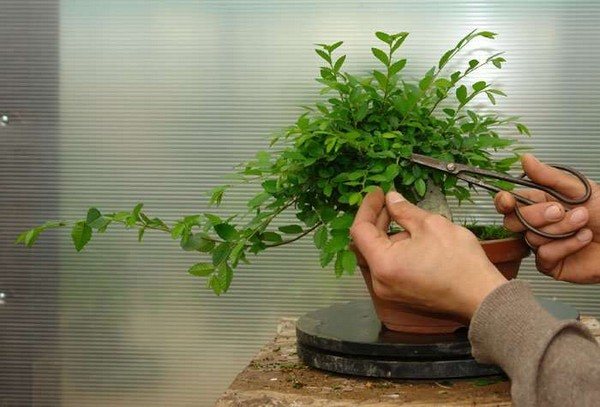

It is better to prune ficus in the spring.
During pruning, the first thing to do is get rid of damaged and dry branches. After that, they begin to form the crown, reducing the length of the shoots, depending on the chosen shape. It is worth noting that sometimes, to give the plant a more attractive, unusual look, its crown is made as lush as possible thanks to the "plexus" of ficuses.
So, for example, if there are two or three young ficuses at home, the crown of which does not look very attractive individually due to the small amount of foliage on the plants, then you can braid them by combining tree branches into one crown. Let's talk about what is needed for this.
- Prepare a large pot for them.
- Carefully remove each plant from its pot and remove a little old soil.
- Fold the trees so that their trunks are located as close to each other as possible.
- Cut off interfering branches.
- Plant flowers in a new prepared pot.
- Sprinkle soil around the edges of the planted flowers.
- Tamp the ground.
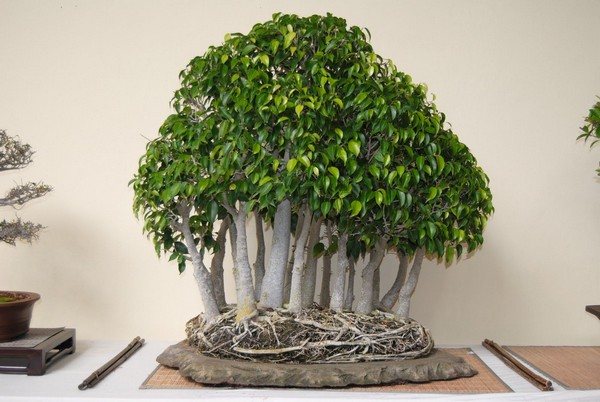

You can braid the crowns of several ficuses
It is important that the plant does not deviate from its original position or collapse due to lack of land. It is recommended to tie the trunks with cotton tape for additional fixation.After that, the crown is finally formed, getting rid of branches or leaves that could not be removed earlier, and also, if necessary, reducing their length.
Growing Difficulties: Problems and Solutions
Ficus Benjamin of the "Natasha" variety is ill infrequently. Difficulties with a flower, as a rule, arise with improper home care. I advise you not to start the process and provide assistance at the first sign of an illness.
The cause can often be found by elimination. To do this, carefully monitor the flower during stressful moments - the first months after purchase, as well as after transplanting and feeding.
Leaves turn yellow and fall
This reaction is typical of Benjamin's ficuses and may indicate a number of reasons:
- Excess and stagnation of moisture. In addition to the yellowness, this is indicated by the lethargy of the leaves. Check the ground if it is wet through and through - do not water the flower for a while. If you haven't changed the pot after purchase, transplant with good drainage.
- Unbalanced potting mix. Perhaps the soil is lacking in nutrients, oversupplied with pesticides, or you overdid it with feeding.
- Hypothermia. Benjamin's ficuses are sensitive to cold, so buy them at freezing temperatures. Do not place them on a cold floor, avoid drafts, contact of leaves with cold window glass.
- Lack of light. If not enough sunlight gets into your windows, put a fluorescent lamp next to Natasha.
- Lack of moisture. In this case, not only yellowing is observed, but also dryness of the leaves. Provide timely watering, spray the crown from a spray bottle in the heat. Once every 1.5-2 months, arrange a warm shower, protecting the roots in the pot with plastic wrap.
Pay attention: the Natasha ficus quickly gets used to a certain place. Therefore, after any manipulations, place the flower in the same place where it stood.
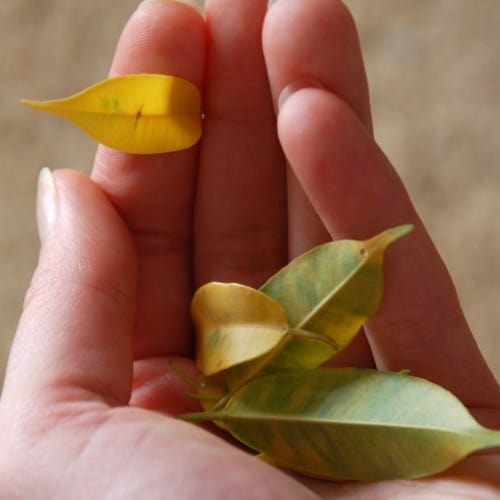

The stem has darkened, the leaves are crumbling
The sign indicates a critical situation with the roots, in which it is close to the death of the plant. This is due to improper planting, poor drainage, and an excess of water. The flower should be transplanted, while carefully inspecting the roots - cut off the rotten ones, treat the rest with a transparent solution of potassium permanganate.
Seat selection
Ficus doesn't like being moved from place to place. Therefore, it is better to immediately determine the location of the pot in such a way that later it does not require transportation. When choosing, you will need to consider a couple of points.
- Ficus should not be placed in a draft or near heating systems.
- The temperature at the place where the flower is grown should not fall below 13 and rise above 28 degrees Celsius.
- The best solution would be to install a tree near the window.


It is better if the plant is located near the window.
As for the plant itself, if it does not like the conditions of "living" in the house, it will begin to shed its foliage. In this case, you should not worry, since this process is quite normal. After some time, the plant will adapt to the new environment and release a new "batch" of leaves.
Prevention is the key to plant health
When buying a ficus Benjamin of the Natasha variety, carefully examine the crown for damage and pests. Do not bring a plant home if you are unsure of its health. After purchasing, move other flowers away from the new ficus for 2-3 weeks. Do not place purchased bouquets from the store next to it.
When purchasing a home ornamental plant, flower growers often opt for not demanding care, but capable of decorating any interior. These plants include Benjamin's Natasha ficus. As a symbol of prosperity and home comfort among the Slavs, as well as a symbol of stability in financial affairs in the Taoist practice of Feng Shui, this plant is very popular and in demand in home floriculture.
What to do right after buying a flower?
After the store, you need to inspect the purchased plant. If the soil is too wet and an unpleasant odor emanates from it, you need to get the ficus out of the flowerpot and carefully examine the roots: all rotten parts must be removed, healthy ones should be washed in a solution of potassium permanganate. After the performed manipulations, plant the plant in a new flowerpot with soil replacement.
If the land of the purchased tree is in satisfactory condition, then it cannot be replanted for 15–20 days - this time is necessary for adaptation to new conditions.
Botanical description and photo
Ficus Benjamin "Natasha" is an evergreen plant of the Mulberry family of the genus Ficus, which is a miniature variety of the Benjamin species.
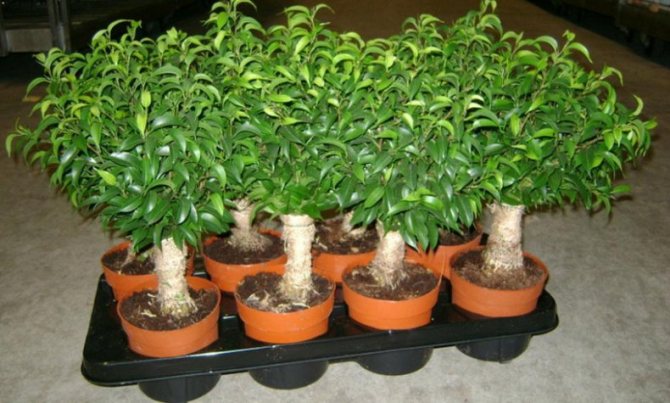

Botanical description of the tree:
- root system: highly developed, powerful, with growth deeper into the pot and in the upper layers of the soil and a gradual rise above it (invasive);
- trunk: narrow, branched, flexible, cylindrical, light brown;
- shoots: drooping, branched;
- leaves: alternate, smooth, with a glossy sheen, curved along the central vein, pointed with smooth edges.
Flowering in ficuses occurs only in the conditions of their natural growth, at home it is unlikely that even experienced flower growers will succeed in achieving flowering at home.
What does a ficus look like
The biological form of the species is a miniature tree 30-100 cm high with many small green leaves, reaching no more than 3 cm in length and forming a lush crown. A voluminous and strong axial trunk, as a rule, forms several trunks of plants planted in one pot and intertwined with each other. Branched shoots of the tree are small, but frequent, requiring systematic pruning and crown formation.


Distribution and birthplace of the plant
Ficus Benjamin "Natasha" is from the tropics. Its natural habitat is North and East Africa, countries of East Asia, Australia. The preferred area for growth is the coast or the foot of the mountains. In natural conditions of temperate latitudes, it can also grow, but basically it is a representative of indoor ornamental plants and as such is widespread throughout the world.
Diseases. Table
| Disease | Signs | Treatment |
| Gray rot | Gray mold appears on foliage and stems | Remove the affected parts of the plant, reduce the frequency of watering, treat with "Alirin-B" or "Vectra" |
| Anthracnose | Rusty spots appear on the leaf plates | Use for processing preparations "Quadrix SK", "Hom", "Alirin-B" |
| Root rot | Ficus withers, rotting areas are visible on the trunk and roots | At the initial stages, it is necessary to remove the decayed parts of the root system, replace the soil and flowerpot, treat with the preparations "Previkur Energy", "Discor", "Gamair". With an advanced form of the disease, the plant cannot be saved |
| Sooty mushroom | On a tree, after being damaged by scabies or aphids, a black-gray bloom forms | Cut off infected leaves, treat the crown and root system with fungicides ("Discor", "Maxim") |
How to choose a plant when buying
A few tips when purchasing a species will help you make the right choice:
- the trunk should not be damaged or fresh cuts;
- branches should not be leafless;
- the leaves should not have any spots and signs of drying;
- the lower part of the leaves should not indicate the presence of any pests;
- the soil should not be dry.
The appearance without signs of wilting indicates health and the absence of pests, which is a guarantee of the right choice when buying.


Pruning
Pruning is a necessary process, thanks to which it is possible to form a correct and beautiful crown. Also, with the help of pruning, you can additionally restore a dried and seemingly dead flower and contribute to its active growth in the future.
If you do not prune the branches of the ficus in time, they will continue to grow in length, decreasing and weakening.Such a result will lead to a deterioration in the health of the plant, as well as negatively affect its appearance.
Important! Pruning is recommended at the beginning of February, when the flower has not yet woken up completely, but the first rudiments of leaves have already appeared. The process involves the removal of long and weak branches, as well as dried parts of plants.
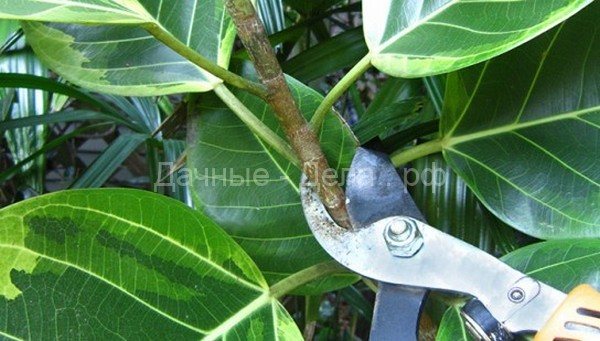

It is very important to prune the flower periodically to make it easier to grow.
As for the frequency of pruning, it is better to do it every year, since the Natasha ficus is considered a fast-growing tree. Pruning shears or garden shears are used as pruning tools.
Where to place the Natasha ficus
Despite all the unpretentiousness of the plant, for good growth and development after acquisition, it is important to correctly position and provide it with comfortable conditions.
Lighting and location
Ficus is a light-loving plant; it owes its glossy leaf surfaces to the sun. For placement in an apartment, southern, well-lit windows are suitable; such an arrangement will save the tree from the curvature of the trunk, which can occur with a lack of light.
Air humidity and temperature
As a representative of the tropics, the species prefers low air humidity. It perfectly tolerates short-term drought and does not tolerate waterlogging. Moderate humidity is provided by moistening the plant with a spray bottle or watering it in a bath. The temperature regime also does not like extremes.
Diseases
The most "popular" disease for this ficus is leaf or spotted rot. It manifests itself in the form of yellowed and fallen leaves. Basically, the occurrence of rot is associated with an unfavorable environment. For example, abundant watering or high humidity can contribute to the spread of the disease.
As a treatment, special drugs should be used. If the fungus has almost completely spread throughout the flower, then the plant will need a transplant.
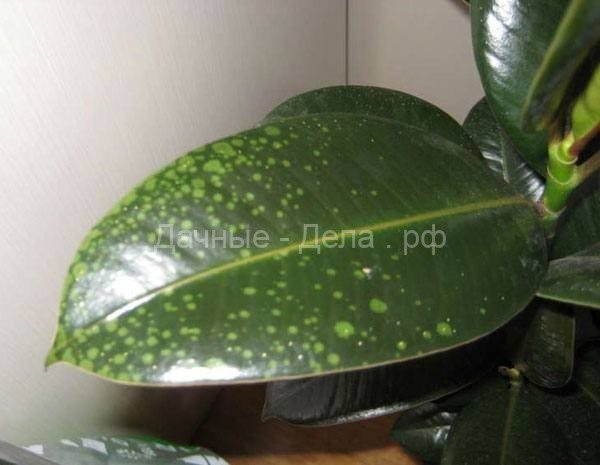

Ficus Natasha is often affected by a fungus
Ficus Benjamina "Natasha": home care
Growing ficus Benjamin "Natasha" does not require special skills, but to ensure optimal conditions for growth, you must familiarize yourself with the basic rules for caring for it.
These rules include:
- watering rules;
- timely fertilization, pruning and transplanting.
Watering rules
The main requirement for watering is timely and moderate soil moisture. The exact time for watering is difficult to predict - the rate of moisture consumption depends on such growing conditions as air humidity and air temperature in the room. Watering should be done when 1 cm of the top layer of the earth is completely dry. In this case, the water should be warm and settled.
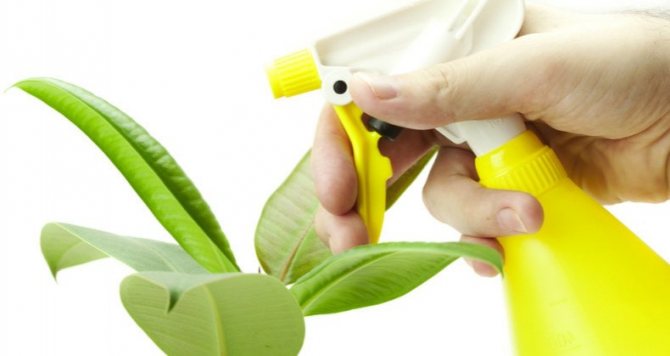

It is worth spilling the soil thoroughly, but after 30 minutes after the procedure, the excess liquid that has drained into the lower container of the pot must be drained. A monthly warm shower will not be superfluous for the view. It can be carried out in the bathroom, while the soil must be covered to avoid waterlogging of the soil. Such a procedure will not only moisturize the plant, but also help get rid of dust that has settled on the glossy surface of the leaves.
Fertilizer
Ficus Benjamin "Natasha" at home does not have a fast and active growth. Timely fertilizing with fertilizers can support the plant and accelerate development. For these purposes, any liquid water-soluble fertilizers for palms and ficuses are suitable, for example, "Palma", "Kemira", "Humisol", "Rainbow" and other fertilizers like these.
Pruning
Regular pruning is an important element for Benjamin's Natasha look. Thanks to timely pruning, dormant buds are stimulated for vegetation, the crown of the tree is formed and its splendor increases.
Pruning lends itself to:
- lower young shoots grown on the trunk;
- branches with very few side shoots and leaves;
- young upper shoots of branches without side shoots or with a small number of them;
- dying branches that have thrown off foliage;
- broken or defective branches.
It is necessary to prune 2-3 times a year, as the plant grows.
Video: pruning ficus variety Natasha
Transfer
The plant is transplanted once every 1-3 years. The transplanting period depends on the initial volume of the flowerpot and the rate of development of the plant. Young plants develop quickly, so transplanting is best done annually. Vegetation and growth of mature plants is slow, which means the need for transplanting once every 2-3 years. In any case, the annual renewal of the topsoil will not be harmful.
- it is necessary to transplant during the period of active development of the plant - in spring or summer. Transplanting during the winter season is not recommended as the plant is dormant and does not have the strength to assimilate new volumes;
- the diameter of the pot should be 2-3 cm larger than the previous one.This rule is explained by the fact that in an excessively large pot, all the forces of the plant will go to the development of the root system, and in an excessively small pot, development will proceed extremely slowly;
- the day before transplanting, the tree must be watered so that the earthen lump remains intact during transshipment;
Video: transplant Timely transplantation in compliance with the rules will give new growth to Benjamin's Natasha ficus.
Watering
The soil should be moistened as it dries up by 2–3 cm. If the temperature regime is observed and the required level of air humidity is maintained, watering is required every 2–3 days in summer and 2 times a month in winter with settled water at room temperature.
Moisture should saturate the entire earthen lump, the excess flowing into the pan through the drainage holes must be drained.
If you are going on vacation
To prevent the soil from drying out, you should moisten the ficus abundantly, wrap the flowerpot with wet paper and polyethylene and cover the plant with a plastic cap or bag - this will reduce the rate of evaporation of water and help maintain the necessary moisture.
How to propagate ficus
The easiest and fastest way to propagate ficus is by cuttings. The right time for breeding is spring and summer, this period is well combined with the process of pruning and crown formation. Young lateral shoots, preferably with a well-developed axial trunk, are suitable as cuttings. The optimal cutting size is from 10 to 12 cm. After pruning, the stalk must be placed in a container with a small amount of water, while it is important that the released milky juice dissolves well in water, freeing the cut for root germination.
Video: how to easily and quickly propagate ficus
Transfer
It is not worth replanting the tree immediately after purchase. The best option would be to transplant after two weeks, since during this time the plant will have time to get used to the indoor climate and the new conditions in which it will grow.
It is best to start a transplant at the beginning of April, since during this period the chances that the plant will take root are significantly increased. In young flowers, transplantation should be carried out every year. In adults, every 3 or 4 years.
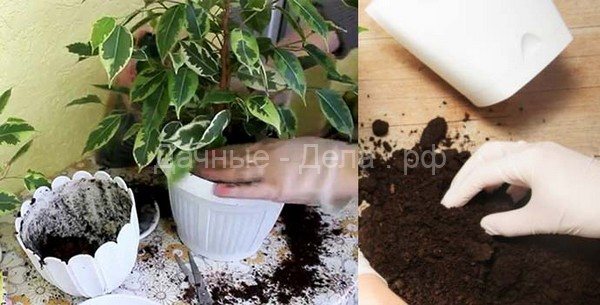

It is better to transplant Natasha ficus in the spring
You can notice that the tree needs replanting on too dry soil. This suggests that the roots are getting cramped in the pot and the incoming moisture is no longer enough for them. Before proceeding with the procedure, you will need to take a pot 3-4 cm larger than the previous one in width and height. A drainage layer is laid out at the bottom of the pot so that the plant takes root and receives the necessary fertilizers, after which the mixture for ficuses is spread.
Finally, to transplant, you will need to carefully remove the flower from the old pot and carefully place it in a new container without getting rid of the soil. At the edges, the tree should be sprinkled with earth and tamped.


It is worth replanting such a plant when it becomes cramped in an old pot.
Plant diseases and pests
Loss of decorative appearance, namely yellowing and falling of leaves, may indicate improper care of the plant or the presence of pests on it. Possible reasons for the appearance of deficiencies:
- lack of light leads to discoloration of the leaves, which requires changing the place of the pot to a more illuminated one;
- brown spots and leaf deformation indicate sunburn and require shading;
- dry tips of leaves indicate a lack of watering, a dry topsoil will also indicate this. Unfortunately, resuming watering, it will not be possible to return the leaves to their previous appearance, but this will help to avoid the appearance of new defects;
- deformation and wilting indicate an excessively low air temperature in the room;
- a change in the temperature regime and location after purchase can also lead to short-term wilting and shedding of leaves; after acclimatization, all development processes are restored.
Among the pests that damage the tree, one can distinguish:
- aphids - the reason for its appearance may be the use of contaminated land, the proximity to a diseased plant or the location of the flower in the open air in the summer season;
- mealybug - feed on plant sap, leading to its death;
- spider mite - also feeds on plant sap and leads to death.
Dry and hot weather or dry air in a hot room are ideal conditions for pests to emerge. For pest control, there are many universal insecticide preparations: "Akarin", "Karbofos", "Fitoverm" and others. The rules for their use are described on the packaging, and the effect after processing them is achieved after the first use.
Signs and superstitions
There are many signs associated with this plant, and in Thailand it is considered sacred at all, believing that good luck will accompany its owner in all endeavors.
The beliefs of various peoples are similar in that the ficus is able to rid the house of any manifestations of negativity, normalize the nervous system of the owners and improve their mood.


People in whose house this tree grows will get rid of fatigue, gain confidence in their abilities, and will look at the world around them much more positively.
Ficus will help in improving material well-being, if you plant it in a green flowerpot, bury a few coins in the ground, provide the tree with proper care and regularly ask for help.
Another ability of the ficus that contributes to its popularity and spread is to help in finding love, establishing strong and trusting relationships between spouses and conceiving a child by couples who have long dreamed of it.
What problems can a florist face
Ficus problems arise with improper care. The most unpleasant and often encountered is yellowing and falling foliage.
There may be several reasons for this:
- lack of light at high air temperatures in winter;
- too rare watering, drying out of the roots;
- too frequent watering, root rot;
- lack or excess of fertilizers;
- cold draft.
Having noticed the problem, it is advisable to accurately establish its cause in order to correct the deplorable position of the ficus.
general description
Ficus Natasha – a dwarf variety of representatives of the Mulberry family, symbolizes well-being and comfort in the house. Under natural conditions, it grows on the islands of Borneo, Java, Ceylon. Wild species sometimes reach 10 m in height, indoor ones cannot even boast of a height of 45 cm.
Thanks to its thin and flexible barrel, from ficus benjamin, spectacular shapes can be formed. Leaves are oval, shiny. You can find varieties with monochromatic and variegated foliage.


Smooth leaves
Ficus Natasha is a miniature tree with smooth leaves. It is easy to clean, which is why it is so popular. Benjamina Natasha has oval-shaped leaves with a glossy sheen.You might think that the leaves are not natural. The length of the leaf can be up to eight centimeters.
The main feature of this plant is the ability to purify the air, therefore, where this tree is, it will always be comfortable to be, since the air remains moist and fresh. Ceylon, Australia and Asia are considered the birthplace of miniature greenery. The flower loves a warm climate
, therefore, under the most favorable conditions, it can grow up to five meters in height. The plant can be classified as mulberry, as evidenced by the shape of the leaf.
How to choose a new pot and how often can you replant
The indoor tree does not tolerate the change of soil and pot. Culture can be severely weakened and slow down development. In rare cases, death occurs. In order to prevent the consequences, the hostess needs to keep control over the frequency of transplants, which depends on the age of the tree:
- the youngest plants need a regular annual procedure;
- after 5 years of life, it can be seated once every 20 months;
- the most mature ficuses do not need replanting, they need regular renewal of the soil layer at the top.
Don't forget! Do not transplant without a good reason. Only pests and roots rotting from waterlogging can cause it.
Pots 3 centimeters larger than the previous one are suitable as new housing. The choice often falls on such "houses":
- Plastic pots. Practical, easy to use and comfortable.
- Clay pots. Here, the plant will definitely not be waterlogged. Clay perfectly absorbs moisture.
- Wooden tubs. Used for transplanting small trees that have reached a decent size.
The right transplant site contributes to the good life of any indoor plant. Before buying, it is necessary to process and check the bottom for the presence of special holes for airing the soil. There are often cases when a flower pot breaks or a tree begins to lose its vitality. Unscrupulous vase manufacturers use cheap plastic to save money. Such material releases toxins upon contact with ground and water, poisoning the ficus. As a result, the plant begins to wilt. It is necessary to replace and correctly select a new container for the life of Benjamin's ficus.


transplanting ficus benjamin into a larger pot
Years of experience gives florists the ability to identify quality flower pots from low-quality ones. Familiar manufacturing companies provide quality plastic products. When choosing a new pot, you need to build on previous experience.
If the ficus has not taken root in a plastic pot, then it is better to use ceramics - it is natural, does not emit toxins, is beautiful and reliable. The material is not cheap, but it gives a one hundred percent guarantee of quality. In size, the new container should be as similar as possible to the old one, otherwise the plant will experience even more stress during transplantation.
Choosing a color is an equally important aspect. Experienced flower growers recommend choosing vases of bright and light colors. They will delight the eye at any time of the year and will attract the attention of guests. The right choice is the key to the comfort of a green tree.
Ideal conditions for keeping ficus
Good conditions for ficus include several aspects of growing - diffused lighting, moderate regular watering, warm indoor air (18 - 25 ° C), timely feeding and air humidity of more than 50%.
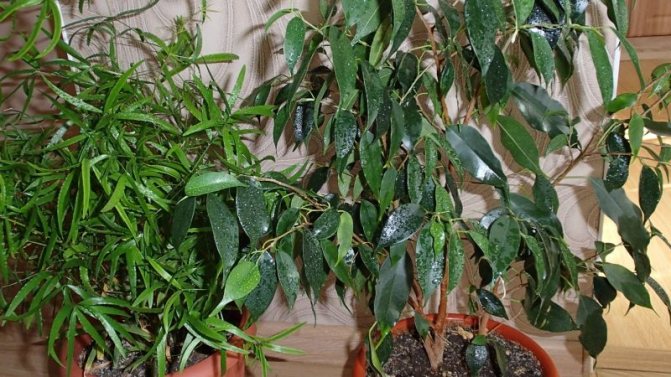

In winter, there are peculiarities of the content depending on the air temperature. However, in any case, it should not fall below 16 ° C. The cooler, the less often the ficus is watered. The topsoil should dry out between waterings to a depth of about 5 cm.
Read also: Scheme of the formation of grapes by years
When choosing a location for a plant, you need to take into account that it does not tolerate drafts. But fresh air is useful in the summer, therefore, when it is warm, the ficus can be taken out onto the balcony, placing it in a corner where it is not blowing.
What should be the microclimate
Ficus feels great at temperatures from +20 ° C to +25 ° C. True, given that in winter all flowers (ficus are no exception) have a rest time, these indicators may be slightly lower.
Important! At temperatures below +10 ° C, the ficus begins to die.
When caring for Natasha ficus, you should also remember about the humidity in the room where the flower stands. The ideal rate will be 50-60%. If the room is stuffy, then it is necessary to regularly spray the flower. It is also recommended to put a container of water next to the pot.
Is it possible to braid a ficus with a pigtail?
The answer is simple - you can. At the same time, a braided plant will look unusual and attractive, pleasing to the eye. To carry out our plans, it will take three Natasha of the same size. Any difference in size will lead to the fact that the pigtail will look ugly and in the process of weaving one ficus can drown out the growth of the second or third.
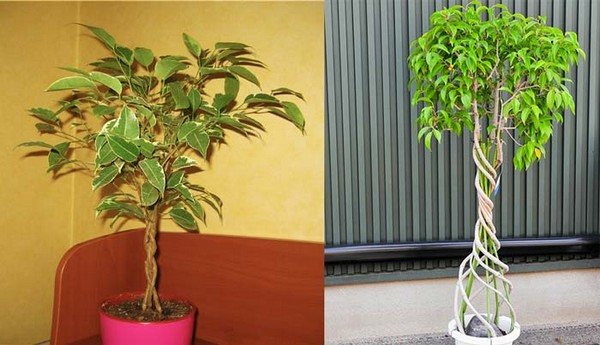

Braided ficus
Weaving is carried out as follows.
- First, preparatory work is required. Such works include pruning of lateral branches and leaves. However, it is worth noting that lignified shoots can not be thrown away, but a new flower can be planted in the future by rooting cuttings.
- After that, you need to choose a weaving method. For example, with a tight braid, the trunks will grow together as a result, forming one plant. A weaker weave will avoid this.
- When it is possible to decide on the type of weaving, it is necessary to remove Benjamin's ficus from the pot and remove excess soil on the sides. A similar procedure must be performed with all three plants.
- Flowers taken out of old containers should be placed in a pot, at the bottom of which you will need to place a mixture of flowers as humus and at the same time decorate.
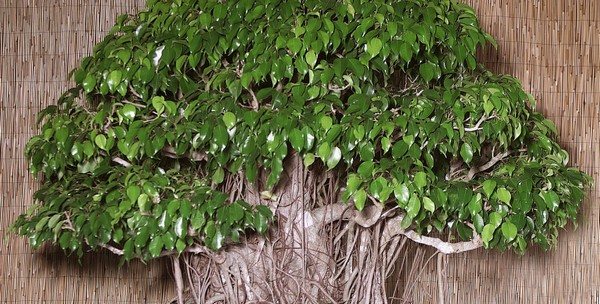

It is important to select plants of the same size.
It will remain, placing the trunks as close as possible, weave them, additionally fixing and fastening with tape. It can be removed afterwards as the mount is no longer needed. To get a beautiful braid, it is recommended to use trees up to 30 cm high.
Is ficus poisonous?
In addition to negative superstitions, the statement that it is poisonous brought unpleasant fame to the flower. Many people think about this before purchasing a ficus, and therefore it is worth understanding this issue.
Ficus is really poisonous, but only for those who are allergic to such plants. The fact is that in the process of growth, the flower secretes a special milk. Its release contributes to the aggravation of allergic reactions in those who are prone to a similar problem.
In this regard, sometimes the acquisition of a ficus plant in the house becomes a truly undesirable decision, and it is better to replace the indoor flower with another that is not allergic. Otherwise, the secreted juice can cause not only irritation, but also cough and asthma. There were also situations when a person had a fever as a result of an allergic reaction.


Some people may be allergic to ficus
But this does not mean that the plant is dangerous for others. No, the flower will only cause problems for those who have an increased sensitivity to the substances contained in Natasha's milk. In all other cases, the plant will not only not be considered poisonous, but will also benefit the house, playing the role of a certain filter.
In the process of growth and development, ficus removes negative substances from the air and produces a huge amount of oxygen. That is why it is recommended to plant a plant in homes for those who live in large and sufficiently polluted cities with exhaust gases.
Thus, ficus is a tree with a rather versatile "reputation". The choice of which signs to believe in depends only on who decided to acquire this flower.However, it is worth noting that if you believe only in the good and take care of the plant, it will definitely improve the atmosphere in your home.
Formation of the crown and trunk
In order for Natalya ficus to be of the necessary beautiful shape, you should systematically trim the crown, thereby forming it. Basically, the tree is shaped like a ball or trunk. It is recommended to prune the tree at the end of the spring season and early summer. If the plant grows strongly, you can prune the branches at other times. Carry out pruning with a well-sharpened and disinfected tool.
Thanks to cutting, not only the crown is formed, but the plant is also rejuvenated. The main shoots are cut so that they are 20 cm long. Each of them should have up to five leaves. The cut should be done above the rudiment, on thick branches at an angle, on the rest - as convenient. To open access to the rays of the sun deep into the crown, it is advised to cut branches in its middle. After finishing the pruning, it is necessary to process all the cuts with charcoal powder.
It is not recommended to prune many branches at one time, it is better to do it gradually. Lateral shoots, if they have grown 10 cm long, are pinched over the bud, turned outward to the crown, so that they do not stick out to the sides.
Due to the flexibility of the ficus trunks, they can be intertwined in several pieces and give them different shapes. So, for example, by connecting 2 shoots, you can get a spiral, 3 - a pigtail. When the trunks are intertwined, all side branches should be trimmed. The branches begin to weave from the moment the trunks get stronger. Fix them with soft threads, you can woolen. Tighten them tightly, but carefully so as not to overwhelm. The barrels are fixed at an oblique angle of 45 degrees. The winding should be changed every 2 months.
To form a long trunk, for the first time, it is necessary to build a support.
The benefits of ficus
Ficus Natali, settling in the house, is of great benefit. The foliage of the plant absorbs harmful substances: phenol and benzene, that is, it cleans the microclimate.
The people call him "Family tree"... Beliefs say that when a ficus appears in the house, then soon you can expect a baby to appear.


Ficus is an unpretentious plant that is not difficult to care for. Having settled in the house, it will serve as an interior decoration for many years. With proper care, ficuses can live for over 15 years.
Ficus "Natasha" is considered a non-capricious plant that easily adapts to new conditions. But caring for him is not as easy as it seems at first glance. The homeland of ficuses is the tropical and subtropical forests of India, China and Southeast Asia, in nature they grow in humid and warm latitudes.
Plant propagation methods
Ficus "Natasha" perfectly reproduces by cuttings. Annual shoots about 10 cm long are suitable for cuttings. Root them in water or immediately in the soil. You can add several activated charcoal tablets to the water with cuttings so that it does not deteriorate.
Many growers prefer to immediately plant cuttings in the ground, arranging for them a small greenhouse.
Planting cuttings for rooting, a description of the process:
- Cut the cuttings with a sharp, clean tool. This can be done at any time of the year, but the growth of ficus is most intense in spring and in the first half of summer, which means that rooting is always more successful at this time.
- The cut is treated with "Kornevin" or simply washed off the sticky white juice so that it does not clog the pores of the plant.
- The lower leaves on prepared cuttings are cut off.
- Drainage and universal soil mixed with sand or perlite are poured into flower pots with a diameter of 8 - 10 cm.
- In each pot, one cutting is stuck vertically to a depth of about 2 cm.
- From above they are covered with a transparent bag or glass jar, after moistening the soil from a spray bottle.
- The cutting is placed for rooting in a bright, warm place, where the air temperature should be at least 20 ° C.Diffuse lighting is preferable, or use shading from 11 am to 3 pm on the south window.
- Every day, the seedlings are aired by opening the greenhouse for 10 minutes. Moisten from a spray bottle as the soil dries.
- Cuttings take root after about three weeks. This is noticeable by the regrowth of new leaves and faster drying of the earth.
- The greenhouse is removed gradually, accustoming the ficus seedlings to the drier air of the room.
You can transplant the rooted stalk into a large container next spring. Ficus "Natasha" is not fast growing, within a year the plant will have time to fill a small planting capacity. Each time the diameter of the pot is increased by only a couple of centimeters - ficuses do not like "extra" space for roots.
Flower transplantation methods and fertilization
Some growers who do not know how to care for Natasha ficus transplant the plant both in winter and in summer, which cannot be done. The presented species does not tolerate such manipulations very well.
Young plants are transplanted only in spring and only once a year. When the ficus has reached the age of three, the procedure should already be performed once every 3-4 years. Older bushes are transplanted only if absolutely necessary. Experienced gardeners recommend simply changing the topsoil in the pot.
All the beauty of a flower lies in its lush crown and the brightness of the leaf plates. However, in order to achieve this, you should regularly make additional fertilizing. The manipulation is carried out from spring to autumn. Nitrogen fertilizers are best suited, although you can buy something else, but you need to look for top dressing for ficus plants.
Care and watering of ficus Benjamin after transplant
After completing the procedure, the plant may begin to shed its leaves, but you should not be afraid of this, since this is a natural reaction to the stress experienced. Soon the tree will grow and develop fully again. If you overfill the soil with water, then soon the roots will begin to rot, and the tree may die from moisture.
After the transplant procedure, it is recommended to water a little. The first spraying with water should be carried out within two days. The main signal for watering is dry soil in a pot. A wooden stick is placed inside the container and pulled out. The stick was left without particles of earth - watering is required. If there are sticky pieces left, then you can and should wait for a few days.
Ficus is a capricious plant, it is difficult to tolerate a change in location. For a plant, it is better to choose a sunny, windless place. Can be placed in a corner where the sun shines in the morning, and closer to noon - a shadow.
How to properly water the plant
Do not forget that ficuses are tropical "inhabitants", so they are quite accustomed to rare irrigation. However, this does not mean at all that the flower can not be watered for months. There are a number of rules on how to correctly and competently perform the manipulation.
These rules are as follows:
- Water for irrigation should be warm (room temperature) and clean (filtered liquid, rain or settled water is suitable).
- The procedure is carried out when the substrate has dried well. However, it did not dry out and did not crack!
- The water remaining in the pan is again poured into the pot, after which they wait 20 minutes, only after that the liquid is completely poured out. It should not be in the pallet, because after a while you can notice that the leaves turn yellow and fall, indicating the beginning of decay of the root system.
- In winter, watering is carried out less frequently than in summer.
How is it different from other varieties?
Today there are 22 varieties of Benjamin ficus. The Natasha variety is considered to be quite popular among lovers of exotic home vegetation. The length of the leaf usually does not exceed 3 cm. The older the leaves, the darker they are.
A distinctive feature of this tree is its relative simplicity. The plant needs to be planted, watered and fed in a timely manner.However, it needs to be protected from direct sunlight. Therefore, on hot days, the tree should be sprayed with water from a spray bottle. It is also important to ventilate the crown daily with gentle shaking.
The advantages of this variety:
- unpretentiousness in comparison with other types;
- the ability to easily form a crown;
- a large number of leaves;
- affordable price for ficus in specialized stores.
This type of ficus allows you to show imagination when pruning the crown. What form it will have depends only on the owner of this tree.
Transplanting ficus Benjamin in the fall
There are emergencies when a tree grows in a poor substrate, often dries up or the soil is too dense. It is not recommended to transplant in the fall. In the period from October to the end of winter, the plant goes into a dormant stage. In order not to bother him once again, the procedure must be performed exclusively by the pass method.


benjamin ficus transplant
The worst option - during the dormant period, the roots of the tree began to rot or an attack of a nematode began. You cannot do without a full-fledged transplant. In such cases, you need to completely process the damaged roots with potassium permanganate and be patient. Transplanting needs to be done twice as carefully, once again without disturbing the roots. Sometimes the plant begins to shed its leaves, wither and slow down development. Due to damage to the root system, there are inevitable deaths.
Important! Root decay during a calm period can lead to the death of the flower.
Shaping the trunk
If the flower was bought in a store, it must be transplanted 30 days after purchase. Further, the tree should be replanted no more than once a year. When replanting, you need to increase the size of the pot as the roots grow. If the ficus has reached a height of 1.5 meters, then you just need to add soil, and not transplant the plant completely.
Ficus does not like changing location
, does not tolerate drafts, as well as heating appliances. The air temperature can withstand from 15 to 27 degrees. In winter, the best temperature is considered to be 17 degrees - this is acceptable during the period of quiet life of the plant. If you do not follow these rules, then the Natasha ficus drops the leaves.
Ficus "Natasha" is considered a non-capricious plant that easily adapts to new conditions. But caring for him is not as easy as it seems at first glance. The homeland of ficuses is the tropical and subtropical forests of India, China and Southeast Asia, in nature they grow in humid and warm latitudes.
Ficus Benjamin "Natasha" is an evergreen houseplant from the Mulberry family. It has a branchy narrow trunk with a light bark. Small dark green leaves 3 cm long, with a pointed end and smooth edges, slightly bent along the central vein like a boat. In indoor conditions, the plant does not bloom.
It differs from other varieties "Natasha" by slow growth, suitable for the formation of bonsai.
Ficus overwinters well at standard room temperature. The main thing in winter care is sufficient air humidity, since the ficus is a very moisture-loving plant. To create favorable conditions, it is sprayed over the leaves from a spray bottle with warm water. It is better to spray daily in summer, and weekly in winter.
Home value
Several beliefs and signs are associated with Benjamin's ficus "Natasha":
- to receive this plant as a gift means to gain longevity and prosperity;
- to see a ficus in a dream for a woman who cannot get pregnant for a long time, which means that her dream will soon come true;
- ficus helps the owner to reveal their potential and replenish the wasted energy;
- the ficus standing in the hallway protects from damage.
Among the representatives of the genus Benjamin's ficus "Natasha" is one of the most unpretentious decorative deciduous specimens. The main thing is to take care of creating a comfortable microclimate and observe the irrigation regime.
Ficus leaves yellowing: problems and solutions
The yellowness of the leaves often has several reasons. By exclusion, you need to determine the one by which the leaves turn yellow in your case. Photos and measures to eliminate yellowness will help you with this. It is worth remembering that failure to provide assistance to the plant at such a moment is fraught with complete loss of leaves.
Ficus Natasha has yellow leaves. Why?
A healthy plant has strong leaves that stick tightly to the stalks. If the leaves began to turn yellow (in whole or in part), fall off - it is worth determining the reason for this. This could be:
- low air temperature if it is winter months, as well as dryness if it is summer;
- improper feeding, that is, excess or lack of nutrients, micro-, macro-elements;
- excess or lack of moisture.
With improper care, the leaves of the ficus turn yellow
It is also worth paying attention to pests (spider mites, scale insects) and fungal diseases that can cause damage to the leaves. However, their external manifestation is different, so it is necessary to deal with the yellowness and drying of the foliage.
Fighting yellowing of leaves, or proper care
So, the reasons for the yellowing of ficus leaves are determined. The following activities will help the flower become healthy:
- maintaining the optimum temperature in a certain season;
- the use of special fertilizers. The seller of the flower shop will help and advise, select the drug for feeding that will contain the right amount of nitrogen, potassium and magnesium, and other important components;
- competent watering in several stages.
Compliance with simple rules will help make Natasha ficus a favorite in the house. They can easily decorate the husband's study, a bathroom with a window or a nursery. And a wonderful living friend will always be there!
It is worth paying attention to the ficus Natasha. This is an amazingly beautiful bush, which in nature reaches 10, and sometimes even 15 meters, and at home does not grow higher than 40-50 cm. Due to the flexible and rather thick trunk, it is possible to create whole masterpieces: by intertwining the trunk, twisting it in such a way that get a designer flower.
The plant stands out with small leaf plates, which do not exceed three centimeters in length, with curved tips. The glossy surface plays beautifully in the sun, adding a special sophistication to the ficus. Depending on the sub-variety, the leaves are of a rich green shade or light, and sometimes even close to white.

